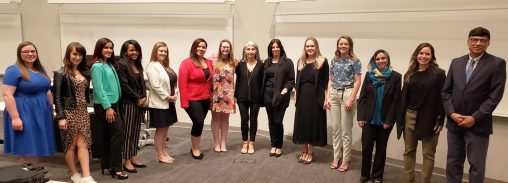
Biomedical engineering students presented their research on how to design a better bra to representatives from Victoria’s Secret.
The brassiere innovation team from Victoria’s Secret paid a visit to Wright State University to attend a briefing on a student research project designed to come up with ways to engineer a better bra.
Students of Tarun Goswami, professor of biomedical, industrial and human factors engineering, each gave brief presentations on their part of the research during a May 9 session in the Neuroscience Engineering Collaboration Building.
There were presentations on breast shapes, the bra-breast interface, asymmetry as it relates to bra fit, the incidence of breast cancer, breast prosthetics and even breast development in men.
Nathalie Martinet, senior vice president of bra innovation, led the four-person delegation of executives and designers for Victoria’s Secret. She called the student presentations very scientific and high level.
“I wasn’t expecting something as formal, as detailed. You can tell that they all know exactly what they are talking about,” she said. “They’re impressive.”
Martinet said her team may return to brainstorm with the students and tap into their expertise.
“I feel that our bras are really high quality and superior to a lot of what’s out there in the market,” she said. “But my team is focusing on how we go to the next level. How do we make it even better? And that’s what we would be trying to do with this group, I think.”
Victoria’s Secret designs, manufactures and markets women’s lingerie, womenswear and beauty products. Headquartered in Columbus, Ohio, the company has more than 1,000 stores around the world. Martinet and her team work out of New York City and Hong Kong.
The students have been working on the research project for more than a year.
“This is our moment. You’re here,” Goswami told the Victoria’s Secret team when they arrived.
The research began as a biomedical engineering project to study the materials used for breast implants. But Goswami suggested the students shift the focus and goal of their research to the bra itself.
“A vast majority of women have problems with bras,” said Goswami. “The students are working to determine if there are health effects of wearing an ill-fitting bra and if a better, more properly fitted bra can be developed. This could affect nearly every woman who wears a bra.”
Farah Hamandi, a biomedical engineering Ph.D. student, organized the latest stage of the project, which initially included five Ph.D., master’s and undergraduate biomedical engineering students. Then several medical students from the Wright State Boonshoft School of Medicine joined the team.
They investigated changes in breast development over the years due to changing hormone levels and the possible effect of age, weight, implants and underwire bras on breast disease.
The project involved taking measurements, manually and via 3D scanning, of the breasts of volunteers to ensure there is a large amount of data for a statistical analysis.
The information, which included 16 different parameters for each breast, was kept strictly confidential. The different shapes of breasts were classified so equations could be formulated to accurately determine surface area and volume and predict the shapes with respect to age using manual, digital and other data from scientific literature.
Martinet said bras are Victoria’s Secret’s core business.
“This is our expertise and this is probably what we do better than anyone else,” she told the students. “We’re focusing on creating innovation in bras to actually impact all of these things that you’ve been studying and identifying.”
The student researchers included Hamandi, Elisabeth Adkins, Carmen Asman, Lazette Carter, Luciana Dewire, Abigail Durst, Anne Lutz, Nakachi Maduka, Trevor Mckoy, Asia Payne, Taylor Pooler, Alicia Runser, Karolayne Silva-Camilo and Alliah Turner.

 Milling around
Milling around  Wright State recognizes Nursing Professor Kim Ringo for advancing international student success
Wright State recognizes Nursing Professor Kim Ringo for advancing international student success  Wright State honors graduating students for distinguished doctoral dissertations
Wright State honors graduating students for distinguished doctoral dissertations  Top 10 Newsroom videos of 2025
Top 10 Newsroom videos of 2025  Museum-quality replica of historic Hawthorn Hill donated to Wright State
Museum-quality replica of historic Hawthorn Hill donated to Wright State 